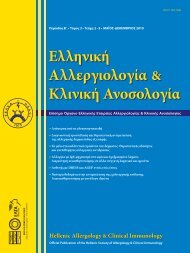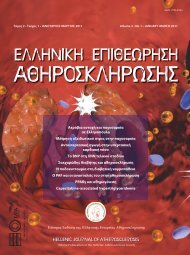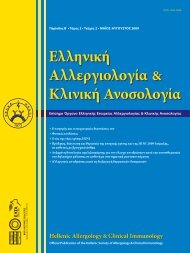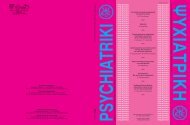ÏÏ ÏιαÏÏικη - ÎÎΤΠÎαÏÏικÎÏ ÎκδÏÏειÏ
ÏÏ ÏιαÏÏικη - ÎÎΤΠÎαÏÏικÎÏ ÎκδÏÏειÏ
ÏÏ ÏιαÏÏικη - ÎÎΤΠÎαÏÏικÎÏ ÎκδÏÏειÏ
- No tags were found...
Create successful ePaper yourself
Turn your PDF publications into a flip-book with our unique Google optimized e-Paper software.
306 H. LAZARATOU et al PSYCHIATRIKI 21 (4), 2010proposes T-scores for 8 first-order factors, 2 second-orderfactors and a total T score, according toage and gender. 21c. Teacher’s Report Form (TRF): This teacher-rated behaviouralinventory on a 3-point scale, yields thesame T-scores as the parents’ CBCL. 22d. Conners-28 item questionnaire: This assesses behaviouraldifficulties to be rated by the teacheron a 4-point scale, "not at all", "just a little", "prettymuch", and “very much present”, coded 0, 1, 2 and3 respectively. It is suitable for children aged 4 to17 years and is designed for ADHD screening. 23,24 Ithas been translated into Greek and standardizedon the Greek population. 25e. Reading ability test: A text based on the AesopianMyth of "The Wise Frog" was used. It is relevant tothe skills, capacities, taught knowledge and interestsof 7–8 years old children. The test consists of95 words (letters’ size 16) similar to the letters ofthe Language Official Handbook (Year 1, Year 2),accompanied by an attractive illustration. The textlevel corresponds to that of the Official Handbookof Greek Elementary School, Grade 1 and 2. 26 Itwas administrated by six specially trained teachers.Their evaluations were checked during a preliminarystudy. There was no statistically significant“teacher” effect. 27 The reading ability was scoredfor: (1) Time (in seconds), from the initial utteredsyllable till reading of the text was completed; (2)Accuracy: number of errors (spelling errors, stresserrors, deletions, substitutions, additions, reversals,reiterations of letters, syllables and words,punctuation deletions and skipping rows of text);(3) Comprehension: number of correct answers to8 specific questions on the text. The test was administeredindividually. Time needed was about10 minutes.ProcedureBefore the study, a meeting took place with allmembers of the research team and teachers involved,to inform them about the aim and the specificprocedures of the study. Teachers were thengiven envelopes with the Conners questionnaireand the Teachers’ Report Form to be completed forall the pupils in their class. In addition, membersof the research team had meetings with parents inthe schools to inform them about the aims of thestudy, the way to complete the CBCL and to answerpossible queries. Every child attending Grade 2 wasthen given a sealed envelope to take home for theirparents, which contained a consent form, a letterfor the parents, the CBCL and a questionnaire concerningthe child’s health history, which were to befilled in and brought back to school. The researchteam later collected the returned envelopes fromthe teachers.Statistical analysisStatistical analysis used the SAS software. Chisquaretest was used for comparison of proportions;Student’s t-test and ANOVA for comparisonof means; and Pearson’s correlation coefficients totest the correlation between two continuous variables.In addition, a Principal Component Analysiswith varimax rotation was performed in order to examinethe structure of the Conner’s Teacher RatingScale.ResultsParent’s questionnaire concerningthe child’s historyThis questionnaire was completed for 85% (n=170)of the children. It was filled in by the mother in 82%of the cases, by the father, in 14% and by either parentsor another person, in 4%. Education level of themother was low, median or high in 10%, 64% and26% of the cases respectively, with similar figures forthe father.Concerning declared problems during pregnancy,the parents gave negative answers for "generalwell-being" in 7.2% of the cases, and positive answersfor "health problems", "psychological problems"and "occurrence of a negative event (such asloss of job)” in 13.7%, 5.2% and 16.9% respectively.In 32.1% of the cases the parents reported "caesarean",8.9% "prematurity" and 11.9% "other" as problemsduring delivery. "Breast- feeding" (duration’srange: 0.3–24 months) was reported in 74.7% of thecases. The parents noted that "my child’s health isgood" in 98.2%, while "chronic diseases" (includ-













